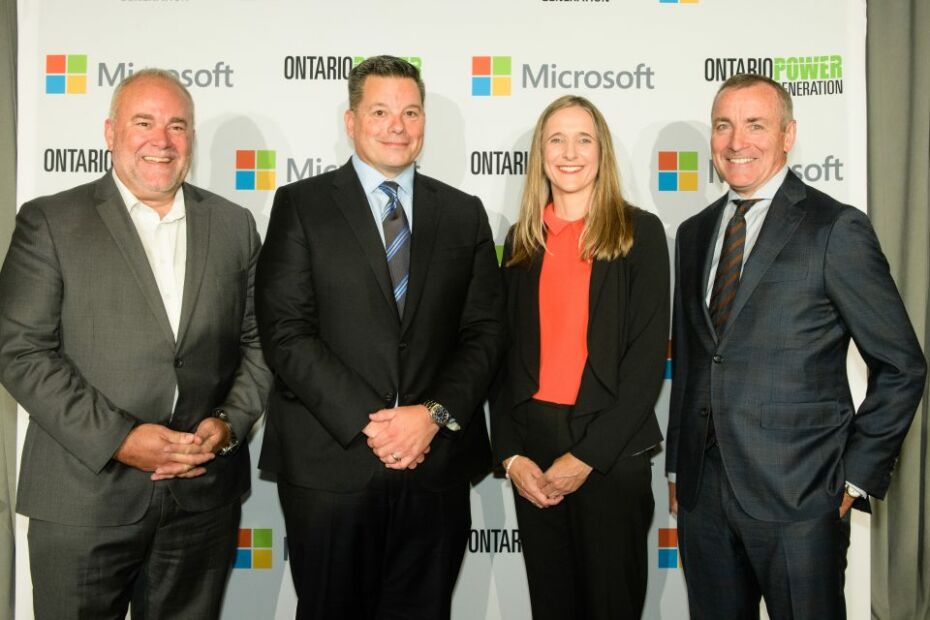Microsoft to support OPG development of SMRs
- October 4, 2022
- William Payne

Ontario Power Generation and Microsoft have announced a Canada-first partnership to drive climate-sustainable growth across Ontario. The two companies will work together on a series of initiatives focused on delivering clean energy solutions and digital skilling programmes, including co-research on developing nuclear Small Modular Reactors.
The two companies will develop an hourly matching platform using Microsoft Azure IoT and AI technology to match a customer’s power needs with local carbon-free energy sources, providing customers greater transparency and accuracy on their emissions impact.
Ontario Power Generation (OPG) and Microsoft will also explore opportunities to accelerate OPG’s nuclear Small Modular Reactor (SMR) programme, with a goal of developing a service that other global energy providers can use in the future to deploy SMRs locally to fast-track clean energy solutions.
Beyond a Clean Energy Credits agreement currently in place, under a recently signed Memorandum of Understanding, Microsoft and OPG will evaluate procurement of CECs associated with the carbon-free energy produced by the soon-to-be-constructed Small Modular Reactor (SMR) at the Darlington New Nuclear Project site.
OPG has chosen Microsoft’s Azure as its cloud platform to modernise applications, IT infrastructure and services. By accelerating migration to the cloud and transforming business operations, OPG will also reduce its carbon footprint.
Microsoft will procure Clean Energy Credits (CECs) sourced from Ontario Power Generation’s (OPG) carbon-free hydro and nuclear assets in Ontario on an hourly basis. This will enable Microsoft to advance progress on its 100/100/0 by 2030 goal whereby Microsoft is committed to powering its datacentres globally with carbon-free energy, around the clock.
Revenue raised through sale of CECs can be used to benefit ratepayers and support investments in new clean generation in the province, helping to meet increased demand for electricity to power Ontario’s economic growth.
As part of the partnership, OPG has also joined the CEO Pledge, an initiative launched by Microsoft Canada, to commit its used technology to the Government of Canada’s Computers for Schools Plus (CSF+) programme, with the goal of bridging the digital divide. The two companies will also roll-out a series of digital skilling initiatives to provide Indigenous communities with tangible opportunities, including skills-building to increase economic and employment options.
“This innovative partnership will not only spur economic development in Ontario, but also serve as a model for other companies and jurisdictions to encourage use of clean hydro and nuclear power,” said Ken Hartwick, OPG President and CEO. “As part of OPG’s Climate Change Plan, we committed to achieving net zero as a company by 2040, and to act as a catalyst for efficient economy-wide decarbonisation. Ensuring industry has access to clean energy to offset emissions assists in meeting that goal.”
“We can only address climate change by tackling the challenge collectively. Agreements like this one with OPG will help Microsoft move closer to achieving our sustainability commitments, including our goal of having 100 percent of our electricity consumption, 100 percent of the time, matched by zero carbon energy purchases by 2030.” said Chris Barry, President, Microsoft Canada. “Working closely with like-minded organisations like OPG, will help us move toward a more sustainable future, while continuing to power innovation in Ontario.”
“As environmental goals increasingly influence corporate decisions on where to invest and grow, this partnership between OPG and Microsoft illustrates the potential for Ontario’s Clean Energy Credit registry to draw businesses from across the world to our province,” said Todd Smith, Minister of Energy. “This voluntary registry will incentivise investments in new clean energy generation and technological innovation while reducing costs for ratepayers.”




